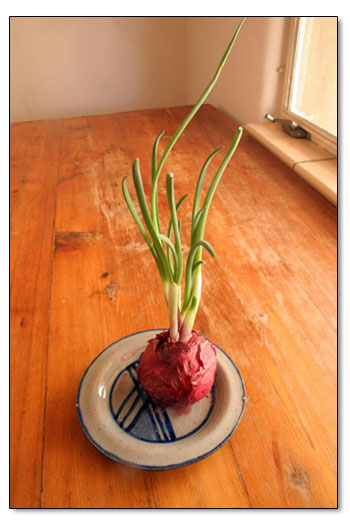|
|
Know thine onionsby Ari Levaux Onions are absolutely fundamental to cooking. I may love garlic more, but I need onions. When I’m in the kitchen, I know my onions like Adam knew Eve. I don’t just use them, I make love to them. This time of year presents unique opportunities for onion knowers, in both kitchen and garden, because last year’s crop is starting to sprout. In your pantry, on the counter, in mesh bags at the local grocery store before you even bring them home, the onion’s yearly urge to grow will no longer be denied. At the very least, what you need to know about sprouting onion season is that you should give your prospective bulbs another squeeze before putting them in the cart, because onions usually soften as they sprout. If you find yourself with some sprouting onions on your hands, and you probably will, it’s worth letting them do their thing on the counter. The sprouts are edible, and taste like scallions. Both sprouted onions and scallions, which are grown from seed, are forms of green onion, and for culinary purposes are virtually identical. Unlike the flesh of the onion bulb, which rarely steals the show in a meal, green onions often stand out, adding bitter pungency where bulbs add sweetness. Green onions are at their best when served raw, when they taste sharp and spicy, and have a bright green radiance. Just a few thin slices of green onion in your miso soup, for example, will crank up the contrast and make it significantly more interesting and beautiful. Those with garden space can and should plant their sprouted onions and watch them grow into rejuvenated, non-rotting versions of themselves. Depending on the onion, and when you plant it, you might get a full-sized bulb again, or a small bulb with a big, stunningly beautiful flower attached. Those without dirt can place their sprouting onions on the windowsill. There you can enjoy their beauty, and do a little pruning anytime you need some green onion pizzazz in your food. If you’re really into it, plant the sprouting onions indoors in pots. If your sprouting onions don’t find you, there are many ways to hunt them down. The adventurous and thrifty might consider dumpster diving behind the grocery store. You could also point out the sprouted onions among the bulk bins inside the store, in hopes the produce manager will let you have them – especially if the bulbs that host the sprouts are soft. If you happen to find a sprouting onion bulb that’s still firm, it’s possible to carefully cut the bulb from around the sprout, leaving the roots at the bottom of the bulb attached to the sprouted part. The firm flesh of the bulb can be eaten, while the sprout can be planted. It seems too good to be true, but the blog Anktangle has a beautifully illustrated post on how to do just this. (www.anktangle.com/2011/03/growing-sprouted-onions.html) While there is adventure to be had in the pursuit of onion greens, casting off in search of half-rotten root crops is not everybody’s idea of a good time. An important part of knowing one’s onions is knowing one’s limitations. Even if the greens of sprouted onions aren’t in your cards, their scallion cousins are coming into season, at the farmers market and the store. Knowing your onions can mean a lot of things, like how to cut them without crying, how to caramelize them without burning, and what raw onions – bulb or green – do in conjunction with browned meat (hint: it’s awesome). This path of discovery is long, but rewarding. To know your onions is more than how you grow, cook and eat them, it’s remembering how much you need them, and to be grateful. Here’s a recipe that will help you know and appreciate the green onions of springtime in a powerful way. Steamed fish with ginger, scallion and soy sauce Make slits, crosswise, on each side of the fish, 1.5 inches apart. Stuff pieces of ginger into each slit. Steam the fish for 10 minutes. If you don’t have a steamer, put the fish on a plate on top of a bowl, or some other prop, inside a pot with water beneath a tight-fitting lid, so the fish steams on the plate. Move the steamed fish onto a serving plate. Pour the sauce over it. Garnish with the chopped hollow onion greens. |
In this week's issue...
- September 11, 2025
- Back on top
After harrowing flying accident, local highliner steps back out with renewed mission
- September 11, 2025
- New order
Rule change for Land and Water Conservation Fund raises alarms
- September 4, 2025
- Armed with knowledge
Local community organizers work to ensure immigrant neighbors know their rights


